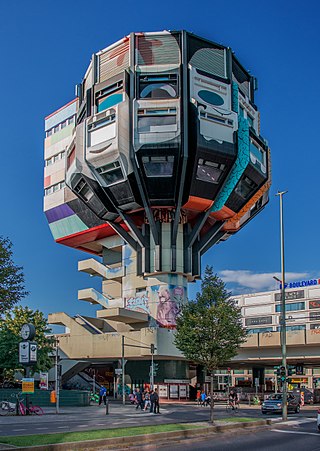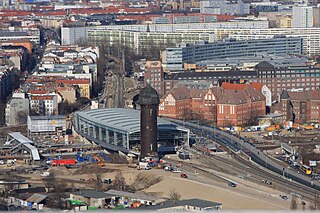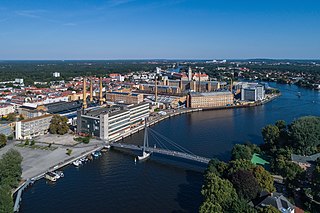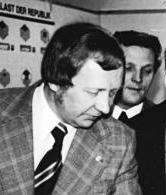
The Schrotkugelturm (Lead shot tower) is the landmark of the Berlin neighbourhood Victoriastadt. The name derives from the former use as shot tower. In 1939 the production of shot balls in this tower was discontinued.

The Schrotkugelturm (Lead shot tower) is the landmark of the Berlin neighbourhood Victoriastadt. The name derives from the former use as shot tower. In 1939 the production of shot balls in this tower was discontinued.
In 1908 the company Bleigießerei und Maschinenfabrik Juhl & Söhne (Lead Foundry and Machine Factory Juhl & Sons), since 1901 owner of the property Nöldnerstraße (formerly known as Prinz-Albert-Straße) 15 & 16, built the rectangular, 38 metre brick tower as part of the factory wing, an extension to their residential and office building. The tower protrudes out of the roof of the building by 18 metres. The platform at the top of the tower can be reached by walking 197 steps.
The design of its facade follows the medieval design of North Italian towers, e.g. in Bologna and San Gimignano.
During the days of the GDR the tower as part of a foundry belonged to the VEB Druckguß und Formbau (VEB Die Casting and Mould Making). The factory was a listed building. With the German reunification it was delisted. Since 1994 the residential building and the tower have become listed buildings once more. Due to extensive damage the tower was renovated between 1998 and 2000 at the cost of 230.000 DM. It is unique in the Berlin and Brandenburg region.
The tower can be visited during the Tag des offenen Denkmals, Germany's contribution to the European Heritage Days, on the second Sunday in September, and during guided tours by the Büro für Industriekultur.
At the topmost storey of the tower lead was heated until molten and then poured into a drop tube. During the free fall the lead drops became seamless spheres.
By the time they reached the water-filled basin at the bottom of the tower the balls had already solidified. Sodium sulfide and oil or tallow were added to the water preventing the oxidation of the shot balls.
The windows in the tower have never been glazed, but were fitted with wooden slats thus providing a draught in the tower which assisted the cooling of the falling shot.

Alexanderplatz is a large public square and transport hub in the central Mitte district of Berlin. The square is named after the Russian Tsar Alexander I, which also denotes the larger neighbourhood stretching from Mollstraße in the north-east to Spandauer Straße and the Rotes Rathaus in the south-west.

The Bierpinsel is the nickname of a 47-meter-high building built in 1976 and located on Schloßstraße in Steglitz, Berlin. The building is noted for its futuristic architecture. The building has been listed as a protected structure since January 2017.
Berlin is the most populous city in the European Union, as calculated by city-proper population.

Fischerinsel is the southern part of the island in the River Spree which was formerly the location of the city of Cölln and is now part of central Berlin. The northern part of the island is known as Museum Island. Fischerinsel is normally said to extend south from Gertraudenstraße and is named for a fishermen's settlement which formerly occupied the southern end of the island. Until the mid-twentieth-century it was a well preserved pre-industrial neighbourhood, and most of the buildings survived World War II, but in the 1960s and 1970s under the German Democratic Republic it was levelled and replaced with a development of residential tower blocks.

Berlin Ostkreuz station is a station on the Berlin S-Bahn suburban railway and the busiest interchange station in Berlin. It is in the former East Berlin district of Friedrichshain, now part of the borough of Friedrichshain-Kreuzberg. A smaller part of the station is in Rummelsburg, part of the borough of Lichtenberg. The station is a Turmbahnhof with the Berlin–Frankfurt (Oder) railway and the Prussian Eastern Railway on the lower level and the Berlin Ringbahn on the upper level. It is used by a total of around 235,000 passengers every day on eight lines, entering or leaving.

Theodor Georg Knorr was an engineer and entrepreneur on the field of railroad technology and founder of the company Knorr-Bremse. He is particularly remembered for his role in the development of the compressed air brake.

Saint Michael's is a former Roman Catholic parish in Berlin, Germany, dedicated to the Archangel Michael. It is noted for its historic church in Mitte, near the border between Berlin-Mitte locality and Kreuzberg. The church was built between 1851 and 1861, and also served as a garrison church for Catholic soldiers. It was heavily damaged by bombing during the Second World War and partially reconstructed in the 1950s. It is protected as a historical monument in Berlin.

Berlin-Rummelsburg Betriebsbahnhof station is a former freight yard, currently used as a Betriebsbahnhof, in the suburb of Rummelsburg in the Lichtenberg district of Berlin. It is primarily used as a depot for the storage and maintenance of passenger train sets used for long-distance traffic. In particular, InterCity Express trains terminating in Berlin are stored there. Deutsche Bahn officially call the station Berlin-Rummelsburg, but it is not to be confused with the more westerly Berlin-Rummelsburg S-Bahn station. The S-Bahn section of the precinct is called S-Bahnhof Betriebsbahnhof Berlin-Rummelsburg, which is classifies as a Haltepunkt. It is served by S-Bahn line .

Oberschöneweide is a German locality (Ortsteil) within the Berlin borough (Bezirk) of Treptow-Köpenick. It is, with Niederschöneweide, part of the geographic area of Schöneweide. Until 2001 it was part of the former borough of Köpenick.

The Fichte-Bunker is a nineteenth-century gasometer in the Kreuzberg district of Berlin, Germany that was made into an air-raid shelter in World War II and subsequently was used as a shelter for the homeless and for refugees, in particular for those fleeing East Berlin for the West. It is the last remaining brick gasometer in Berlin.
The Großgaststätte Ahornblatt was a building located in the Mitte district of Berlin. Built between 1971 and 1973 as part of the new Fischerinsel residential condominium project, it accommodated a self service restaurant with 880 seats and a shopping arcade for the employees of the East German Ministry of Construction and for the workers of other nearby offices. Despite protests, the building was demolished in 2000.

The Monument to Freedom and Unity is a planned national German monument in Berlin commemorating the country's peaceful reunification in 1990 and earlier 18th, 19th and 20th century unification movements.

The Prussian National Monument for the Liberation Wars is a war memorial in Berlin, Germany, dedicated in 1821. Built by the Prussian king during the sectionalism before the Unification of Germany it is the principal German monument to the Prussian soldiers and other citizens who died in or else dedicated their health and wealth for the Liberation Wars (Befreiungskriege) fought at the end of the Wars of the Sixth and in that of the Seventh Coalition against France in the course of the Napoleonic Wars. Frederick William III of Prussia initiated its construction and commissioned the Prussian Karl Friedrich Schinkel who made it an important piece of art in cast iron, his last piece of Romantic Neo-Gothic architecture and an expression of the post-Napoleonic poverty and material sobriety in the liberated countries.

Altes Stadthaus is a former administrative building in Berlin, currently used by the Senate. It faces the Molkenmarkt and is bound by four roads; Jüdenstraße, Klosterstraße, Parochialstraße, and Stralauer Straße. Designed by Ludwig Hoffmann, chief of construction for the city, it was built in 1902–11 at a cost of 7 million marks (US$1,750,000) to supplement the Rotes Rathaus.

The Embassy of France in Berlin is the diplomatic mission of the French Republic in Germany. Designed by Christian de Portzamparc and completed in 2002, it is at the same address, Pariser Platz 5, as the former embassy which was destroyed in World War II. Prior to German reunification, France had an embassy in the German Democratic Republic at a different address in Berlin and an embassy in the Federal Republic in Bonn.

Heinz Graffunder was a German architect.

The Berlin Stalin statue was a bronze portrayal of the Soviet leader Joseph Stalin. A Komsomol delegation had presented the sculpture to the East Berlin government on the occasion of the Third World Festival of Youth and Students in 1951. The monument was formally dedicated on 3 August 1951 after temporary placement at a location on a newly designed and impressive boulevard, Stalinallee, being constructed at the time in what was then the Berlin district of Friedrichshain. Stalin monuments were generally removed from public view by the leadership of the Soviet Union and other associated countries, including East Germany, during the period of De-Stalinization. In Berlin the statue and all street signs designating Stalinallee were hastily removed one night in a clandestine operation and the street was renamed Karl-Marx-Allee and Frankfurter Allee. The bronze sculpture was smashed and the pieces were recycled.

The World Clock, also known as the Urania World Clock, is a large turret-style world clock located in the public square of Alexanderplatz in Mitte, Berlin. By reading the markings on its metal rotunda, the current time in 148 major cities from around the world can be determined. Since its erection in 1969, it has become a tourist attraction and meeting place. In July 2015, the German government declared the clock as a historically and culturally significant monument.

Ernst Karl Eugen Koerner was a German landscape painter.
Hans-Jürgen Mende was a German historian. He was a lecturer in the history of philosophy at the Weißensee Academy of Art Berlin. After the reunification of Germany (1989/90) he became founder and managing director of the social and cultural-historical association Luisenstädtischer Bildungsverein, whose main aim was the research and spreading of the history of Berlin and Brandenburg.